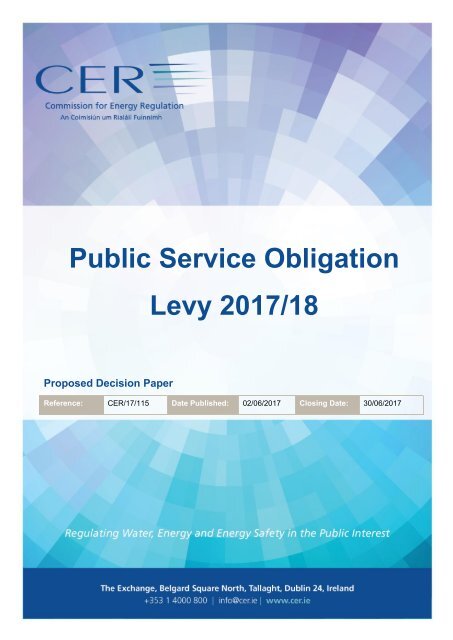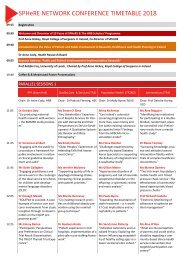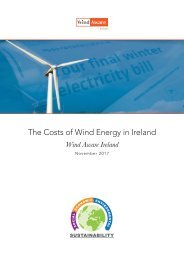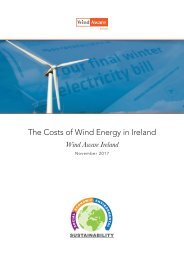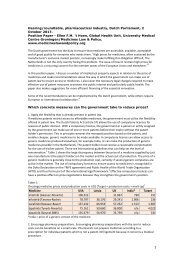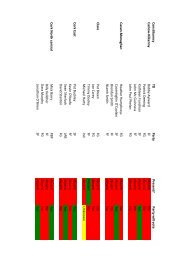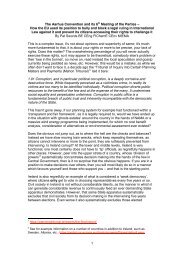CER17115 Proposed Decision Paper - Public Service Obligation Levy 2017-18
You also want an ePaper? Increase the reach of your titles
YUMPU automatically turns print PDFs into web optimized ePapers that Google loves.
<strong>Public</strong> <strong>Service</strong> <strong>Obligation</strong><br />
<strong>Levy</strong> <strong>2017</strong>/<strong>18</strong><br />
<strong>Proposed</strong> <strong>Decision</strong> <strong>Paper</strong><br />
Reference: CER/17/115 Date Published: 02/06/<strong>2017</strong> Closing Date: 30/06/<strong>2017</strong>
Executive Summary<br />
The <strong>Public</strong> <strong>Service</strong> <strong>Obligation</strong> (PSO) levy is a subsidy charged to all electricity<br />
customers in Ireland. It is designed by the Irish Government and consists of various<br />
subsidy schemes to support its national policy objectives related to renewable energy<br />
and indigenous fuels (peat).<br />
Government determines the level of subsidy provided to generators supported under<br />
the PSO, with the CER’s primary role being the calculation of the PSO levy.<br />
Specifically, in accordance with Government policy, the CER’s role is to calculate the<br />
PSO levy annually based on support rates that are set by Government, and to help<br />
ensure that the scheme is administered appropriately and efficiently. The CER has<br />
therefore prepared this proposed decision paper (CER/17/115), which sets out the<br />
proposed PSO levy to apply to electricity customers from 1 October <strong>2017</strong> to 30<br />
September 20<strong>18</strong>.<br />
Following a review of PSO cost submissions from eligible suppliers, the CER’s initial<br />
calculation is that a PSO levy of €496.5 million will be required for the <strong>2017</strong>/<strong>18</strong> PSO<br />
period, which represents an increase of €104.1 million (27%) on the 2016/17 levy of<br />
€392.4 million. A number of drivers are contributing to the increase in the PSO levy,<br />
including in particular, increased renewable generation and an increased R-factor<br />
arising from the 2015/16 PSO period.<br />
From a customer impact perspective, the <strong>2017</strong>/<strong>18</strong> PSO levy, as currently proposed,<br />
will result in a monthly charge of €8.27 and €28.79 for domestic and small commercial<br />
customers respectively. In comparison to the 2016/17 PSO, this equates to a monthly<br />
increase of €2.37 and €8.06 for domestic and small commercial customers<br />
respectively. Customers in the medium/large commercial category will be subject to a<br />
monthly charge of €3.74/kVA, which constitutes an increase of €0.41/kVA relative to<br />
2016/17.<br />
In contrast to the 2016/17 PSO levy, a higher proportion of the PSO levy will be<br />
allocated to domestic and small commercial customers relative to medium/large<br />
commercial customers. This redistribution of the PSO levy has resulted from an update<br />
to ESB Networks’ PSO Cost Allocation Methodology.<br />
The final PSO levy for the <strong>2017</strong>/<strong>18</strong> PSO year will be published by the CER before the<br />
statutory deadline of 1 August <strong>2017</strong>. However, due to potential changes arising from<br />
a revised forecast benchmark price and capacity payment, and a further review of<br />
PSO cost submissions, it is envisaged that the final <strong>2017</strong>/<strong>18</strong> PSO levy will differ from<br />
the indicative PSO levy discussed in this paper. This difference to the levy may be an<br />
increase or a decrease, depending on the final forecast figures and the outcome of<br />
the review of submitted costs.<br />
1
<strong>Public</strong>/Customer Impact Statement<br />
For the year starting 1 October <strong>2017</strong>, the CER has calculated that the PSO <strong>Levy</strong> will<br />
increase by 27% in total. This means that each household will pay €2.37 per month<br />
more on their electricity bill than in the current PSO year. Business customers will<br />
also pay an increased PSO <strong>Levy</strong>. This increase is mainly due to a significant growth<br />
in the level of renewable generation expected to materialise in the next year. In 2016,<br />
around 25% of Ireland’s electricity was generated from renewable sources. This is<br />
increasing as Ireland moves towards its target of 40% renewables in electricity by<br />
2020.<br />
2
Table of Contents<br />
EXECUTIVE SUMMARY ................................................................................................................ 1<br />
PUBLIC/CUSTOMER IMPACT STATEMENT ................................................................................................... 2<br />
TABLE OF CONTENTS .................................................................................................................. 3<br />
GLOSSARY OF TERMS AND ABBREVIATIONS ................................................................................ 4<br />
1. INTRODUCTION ................................................................................................................... 5<br />
1.1 THE COMMISSION FOR ENERGY REGULATION .................................................................................. 5<br />
1.2 PURPOSE OF THIS DOCUMENT ...................................................................................................... 5<br />
1.3 STRUCTURE OF THIS DOCUMENT ................................................................................................... 5<br />
1.4 RESPONDING TO THIS DOCUMENT ................................................................................................. 6<br />
1.5 RELATED DOCUMENTS ................................................................................................................. 6<br />
2. BACKGROUND ..................................................................................................................... 8<br />
2.1 THE PSO LEVY ........................................................................................................................... 8<br />
2.2 LEGISLATIVE FRAMEWORK GOVERNING THE PSO ............................................................................. 9<br />
3. KEY ASSUMPTIONS ............................................................................................................ 10<br />
3.1 BENCHMARK PRICE ................................................................................................................... 10<br />
3.2 CAPACITY PAYMENT .................................................................................................................. 10<br />
4. PROPOSED <strong>2017</strong>/<strong>18</strong> PSO LEVY ........................................................................................... 12<br />
4.1 TOTAL LEVY COST AND GENERATION CAPACITY SUPPORTED .............................................................. 12<br />
4.2 DRIVERS OF YEAR ON YEAR CHANGE ............................................................................................. 13<br />
4.3 ALLOCATION OF COSTS .............................................................................................................. 14<br />
5. COST BREAKDOWN OF PROPOSED LEVY ............................................................................. 16<br />
5.1 OVERVIEW OF SUPPORT SCHEMES................................................................................................ 16<br />
5.2 R-FACTOR ................................................................................................................................ 19<br />
5.3 PSO CFDS ............................................................................................................................... 20<br />
5.4 CREDIT FROM 16/17 PSO LEVY .................................................................................................. 20<br />
6. NEXT STEPS ....................................................................................................................... 21<br />
APPENDIX 1 .............................................................................................................................. 22<br />
3
Glossary of Terms and Abbreviations<br />
Abbreviation or Term<br />
ACPS<br />
AD<br />
AER<br />
CfD<br />
CHP<br />
MIC<br />
MWh<br />
PPA<br />
PSO<br />
REFIT<br />
SEM<br />
S.I.<br />
SMP<br />
Definition or Meaning<br />
Annual Capacity Payment Sum<br />
Anaerobic Digestion<br />
Alternative Energy Requirement<br />
Contract for Difference<br />
Combined Heat and Power<br />
Maximum Import Capacity<br />
Megawatt Hours<br />
Power Purchase Agreement<br />
<strong>Public</strong> <strong>Service</strong> <strong>Obligation</strong><br />
Renewable Energy Feed-In-Tariff<br />
Single Electricity Market<br />
Statutory Instrument<br />
System Marginal Price<br />
4
1. Introduction<br />
1.1 The Commission for Energy Regulation<br />
The Commission for Energy Regulation (CER) is Ireland’s independent energy and<br />
water regulator. The CER was established in 1999 and now has a wide range of<br />
economic, customer protection and safety responsibilities in energy. The CER is also<br />
the regulator of Ireland’s public water and wastewater system. Our mission is to<br />
regulate water, energy and energy safety in the public interest.<br />
Further information on the CER’s role and relevant legislation can be found on the<br />
CER’s website at www.cer.ie.<br />
1.2 Purpose of this Document<br />
This document explains the proposed <strong>Public</strong> <strong>Service</strong> <strong>Obligation</strong> (PSO) levy to apply<br />
to electricity customers in Ireland from 1 October <strong>2017</strong> to 30 September 20<strong>18</strong>. A final<br />
decision on the PSO levy will be issued by 1 August <strong>2017</strong> in compliance with statutory<br />
requirements.<br />
1.3 Structure of this Document<br />
The remainder of this document is structured as follows:<br />
Section 2 – Background: Provides detail on the PSO levy and the legislative<br />
framework governing the PSO.<br />
Section 3 – Key Assumptions: Provides detail on the benchmark price and capacity<br />
payment used in calculating the proposed PSO levy for <strong>2017</strong>/<strong>18</strong>.<br />
Section 4 – <strong>Proposed</strong> <strong>2017</strong>/<strong>18</strong> PSO <strong>Levy</strong>: Gives a high level overview of the<br />
proposed PSO levy in terms of total cost and total generation capacity supported, as<br />
well as the allocation of the cost to different customer categories.<br />
Section 5 – Cost Breakdown of <strong>Proposed</strong> <strong>Levy</strong>: Provides a breakdown of the<br />
proposed PSO levy in terms of the support schemes and generation technologies that<br />
it supports.<br />
Section 6 – Next Steps<br />
Appendix 1: Contains key data from ESB Networks’ model used to allocate the<br />
proposed PSO levy to the different categories of customer.<br />
5
1.4 Responding to this Document<br />
Responses to this proposed decision paper should be forwarded to Grainne Black by<br />
close of business on 30 June <strong>2017</strong>, preferably in electronic format to PSO@cer.ie or<br />
alternatively by post to:<br />
Grainne Black<br />
Commission for Energy Regulation<br />
The Exchange<br />
Belgard Square North<br />
Tallaght<br />
Dublin 24<br />
The CER plans to publish all responses received to this proposed decision paper on<br />
the CER’s website unless any objection to this is notified in the response to the CER<br />
by a respondent.<br />
1.5 Related Documents<br />
Legislation<br />
Electricity Regulation Act, 1999<br />
S.I. No. 217 of 2002 - Electricity Regulation Act, 1999 (<strong>Public</strong> <strong>Service</strong><br />
<strong>Obligation</strong>s) Order 2002 as amended<br />
S.I. No. 284 of 2008 – Amending S.I. No. 217 of 2002 for REFIT<br />
S.I. No. 444 of 2009 – Amending S.I. No. 217 of 2002 for REFIT<br />
S.I. No. 532 of 2010 – Amending S.I. No. 217 of 2002 for REFIT<br />
S.I. No. 513 of 2011 – Amending S.I. No. 217 of 2002 for REFIT<br />
S.I. No. 438 of 2012 – Amending S.I. No. 217 of 2002 for REFIT<br />
S.I. No. 421 of 2013 – Amending S.I. No. 217 of 2002 for REFIT<br />
S.I. No. 603 of 2014 – Amending S.I. No. 217 of 2002 for REFIT<br />
S.I. No. 556 of 2015 – Amending S.I. No. 217 of 2002 for REFIT<br />
S.I. No. 600 of 2016 – Amending S.I. No. 217 of 2002 for REFIT<br />
EU State Aid Notifications and Clearance <strong>Decision</strong>s<br />
<br />
State Aid N 553/2001: AER<br />
State Aid N 826/2001: AER I-V<br />
State Aid N 475/2003: Capacity and Differences Agreements (CADA)<br />
State Aid N 571/2006: REFIT 1<br />
State Aid SA.31236 (2011/N): REFIT 2<br />
State Aid SA.3<strong>18</strong>61 (2011/N): REFIT 3<br />
6
CER <strong>Paper</strong>s<br />
PSO Benchmark Price Setting Methodology <strong>Decision</strong> <strong>Paper</strong> (AIP-SEM-07-431)<br />
Arrangements for the <strong>Public</strong> <strong>Service</strong> <strong>Obligation</strong> <strong>Levy</strong> (CER/08/153)<br />
Calculation of the R-factor in determining the PSO levy (CER/08/236)<br />
Arrangements for the <strong>Public</strong> <strong>Service</strong> <strong>Obligation</strong> <strong>Levy</strong> – A <strong>Decision</strong> by the<br />
Commission for Energy Regulation (CER/08/153)<br />
2016/17 PSO <strong>Decision</strong> <strong>Paper</strong> (CER/16/252)<br />
<strong>Decision</strong> on Updated Cost Allocation Methodology (CER/17/073)<br />
Notification to Suppliers – Submissions to the CER in relation to the <strong>2017</strong>/<strong>18</strong><br />
PSO <strong>Levy</strong> (CER/17/022)<br />
Notification to Suppliers – Engagement of Auditors Regarding Certification for the<br />
PSO <strong>Levy</strong> (CER/17/021)<br />
7
2. Background<br />
2.1 The PSO <strong>Levy</strong><br />
The PSO levy is charged to all electricity customers in Ireland. It covers various<br />
subsidy schemes designed by the Irish Government to support its national policy<br />
objectives related to renewable energy and the use of indigenous fuels (peat) 1 .<br />
Given that PSO-supported generation typically costs more to deliver than it can earn<br />
in the market, PSO-supported generators can enter into contracts with suppliers,<br />
which guarantee them a certain price. The PSO levy is used to pay the difference<br />
between this price and the price that can be earned in the market.<br />
The policy and terms associated with the generation plants supported by the PSO<br />
levy are mandated by Government in legislation and approved by the European<br />
Commission, see Section 2.2. The CER has no discretion over the terms of PSO<br />
schemes. The CER’s only role in relation to the PSO is to calculate the levy in<br />
accordance with Government policy and to help ensure that the scheme is<br />
administered appropriately and efficiently.<br />
The PSO levy is collected from electricity customers by their electricity suppliers. The<br />
levy collected is passed to ESB Networks and then EirGrid. EirGrid pays out the<br />
appropriate PSO amounts to PSO-supported generators/suppliers.<br />
The PSO levy is calculated in advance each year for the forthcoming PSO period 1<br />
October to 30 September. It principally consists of:<br />
1. The estimated eligible costs that generators/suppliers are forecast to incur in<br />
the forthcoming PSO period. These costs are then reduced by the level of<br />
market revenue which is forecast to be earned. The market revenue is forecast<br />
based on a benchmark wholesale electricity price and capacity payment, which<br />
are set by the CER.<br />
2. A settlement for the PSO period two periods prior to the forthcoming period.<br />
As the PSO <strong>Levy</strong> for each year is based on estimated costs and forecast<br />
market revenues, there is also an adjustment made when the full actual costs<br />
and revenues are known. This adjustment is known as the “R-factor”. The R-<br />
factor may be positive or negative, depending on whether the actual costs<br />
incurred are higher or lower than had been estimated. The differences can<br />
arise primarily due to differences between the estimated and the actual level<br />
of generation and to differences between the estimated and the actual market<br />
payments received. The PSO <strong>Levy</strong> for each 12 month period therefore includes<br />
1<br />
Until 2016, it also supported security of supply policy objectives.<br />
8
oth the estimate of the levy costs for that period, and the R-factor adjustment<br />
for the PSO period two years previous.<br />
2.2 Legislative Framework Governing the PSO<br />
In accordance with Section 39 of the Electricity Regulation Act, 1999, the CER is<br />
directed by order of the Government to impose the PSO on electricity market players.<br />
Statutory Instrument (S.I.) No. 217 of 2002 sets out more detail in relation to the PSO<br />
levy rules. It provides for the calculation of the PSO levy by the CER in accordance<br />
with State Aid Notifications to the European Commission for the various PSO<br />
schemes.<br />
The original State Aid Notification 2 of November 2000 sets out the broad areas that<br />
may be covered by the PSO as listed in Section 39 of the Electricity Regulation Act,<br />
1999. These are security of supply, use of indigenous fuel sources and environmental<br />
protection. It refers specifically to the schemes developed at that time i.e. support for<br />
the generation of electricity from peat and from renewable, sustainable or alternative<br />
forms of energy.<br />
Since the original notification, new schemes have been notified by the Government<br />
to the EU Commission and have received state aid clearance. These include the AER<br />
(Alternative Energy Requirement) schemes, as well as the “Capacity 2005” plants,<br />
which were supported under the PSO in order to address security of supply concerns.<br />
In 2006, the REFIT 1 scheme was notified to the EU and in 2011 REFIT 2 and REFIT<br />
3 were notified to the EU and received state aid clearance to provide support for the<br />
generation of electricity from renewable technologies. S.I. No. 217 has been amended<br />
by successive S.I.s to provide for the recovery of costs under the PSO for each of the<br />
above schemes.<br />
2<br />
The purpose of the Notification was to inform the European Commission of the Irish Government’s intention<br />
to impose public service obligations and of the proposed mechanism to recover the additional costs of fulfilling<br />
the obligations.<br />
9
3. Key assumptions<br />
3.1 Benchmark price<br />
The benchmark price is an average of the forecast wholesale market price of<br />
electricity, the SMP, in the SEM over the PSO period. It is used by the CER to<br />
calculate the forecast market revenue of generation plants supported under the PSO<br />
for the given PSO period, based on their estimated generation. This forecast market<br />
revenue is subtracted from the guaranteed revenue of the supported plants in order<br />
to determine the amount to be paid via the PSO levy. The lower the benchmark price,<br />
the higher the top up required from the PSO levy and vice versa.<br />
The benchmark price used is a time weighted average of the half-hourly SMP for the<br />
PSO period, calculated using a PLEXOS model of the SEM. For clarity, this SEM<br />
model has been applied to the entire PSO period from Oct <strong>2017</strong> to Sept 20<strong>18</strong>,<br />
although the new I-SEM market will go live during this period, in May 20<strong>18</strong>. Any<br />
difference due to the use of this model between the benchmark price applied here<br />
and actual I-SEM prices, will be captured in the R-factor for the <strong>2017</strong>/<strong>18</strong> PSO period.<br />
For the purpose of calculating the PSO levy contained in this proposed decision<br />
paper, a forecast benchmark price of €44.50/MWh has been used. The exchange<br />
rates and forward fuel and carbon prices used in modelling the <strong>2017</strong>/<strong>18</strong> PSO period<br />
are from the 28 April <strong>2017</strong>, with the main determinant of the benchmark price being<br />
the forward fuel prices. It is envisaged that there will be a change to forward fuel prices<br />
and therefore to the benchmark price before the decision paper containing the final<br />
PSO levy is published (by 1 August <strong>2017</strong>).<br />
3.2 Capacity payment<br />
For the purpose of the PSO, the capacity payment figure is used to estimate the<br />
revenue a generator will earn via the Capacity Payment Mechanism (CPM) in the<br />
SEM. The CPM remunerates generators for the provision of generation capacity. The<br />
Annual Capacity Payment Sum (ACPS) is published annually on the SEM Committee<br />
website, where the ACPS for <strong>2017</strong> can be found 3 . The figure for the 20<strong>18</strong> ACPS has<br />
not yet been finalised, so the latest information available has been used for the<br />
purpose of this proposed decision paper. Consequently, an average capacity<br />
payment figure of €5.40/MWh has been calculated for the <strong>2017</strong>/<strong>18</strong> PSO period.<br />
However, the mechanism for the remuneration of capacity will be fundamentally<br />
different in the new I-SEM market and intermittent generators are expected to receive<br />
3<br />
ACPS <strong>2017</strong> <strong>Decision</strong> <strong>Paper</strong><br />
10
minimal capacity revenue as a result. In order to take into account this anticipated<br />
reduction in capacity revenue following I-SEM go live, the capacity payment figure for<br />
wind generators has been calculated on the basis of the total monies available from<br />
the ACPS for the period October 17 – May <strong>18</strong>, rather than for the full PSO period.<br />
This results in a lower average capacity payment figure for wind generators of<br />
€3.87/MWh and a correspondingly lower estimate of the revenue these generators<br />
will earn from capacity payments.<br />
Any difference between the capacity payments estimated based on this figure and the<br />
actual capacity revenue in I-SEM, will be captured in the R-factor for the <strong>2017</strong>/<strong>18</strong> PSO<br />
period.<br />
11
4. <strong>Proposed</strong> <strong>2017</strong>/<strong>18</strong> PSO levy<br />
4.1 Total levy cost and generation capacity supported<br />
The total PSO levy for the <strong>2017</strong>/<strong>18</strong> period, calculated based on the benchmark price<br />
and capacity payment assumptions described in Section 3, is €496.5 million. A high<br />
level breakdown of the <strong>2017</strong>/<strong>18</strong> PSO levy into its components is shown in Table 1.<br />
Component<br />
Generation<br />
capacity<br />
supported (MW)<br />
Forecast cost<br />
<strong>2017</strong>/<strong>18</strong><br />
(€ million)<br />
R-factor<br />
2015/16<br />
(€ million)<br />
Total PSO<br />
support <strong>2017</strong>/<strong>18</strong><br />
(€ million)<br />
Renewables 3334 350.9 42.5 393.5<br />
Peat 250 110.2 14.5 124.7<br />
Security of Supply — — -7.3 -7.3<br />
PSO CfDs — — — -11.2<br />
Admin — — — 1.3<br />
Credit from 2016/17 — — — -4.5<br />
Total 3584 461.1 49.7 496.5<br />
Table 1: Breakdown of total proposed PSO levy<br />
Additionally, Figure 1 provides an annual breakdown of the total PSO levy since 2011-<br />
12 and presents the overall trend in the cost of the PSO.<br />
Figure 1: Trend in total PSO levy amount and breakdown by component<br />
12
4.2 Drivers of year on year change<br />
The proposed PSO levy for <strong>2017</strong>/<strong>18</strong> of €496.5 million represents an increase of<br />
€104.1 million (27%) on the 2016/17 levy of €392.4 million. A number of drivers are<br />
contributing to the increase in the <strong>2017</strong>/<strong>18</strong> PSO levy, principally increased renewable<br />
generation and the 2015/16 R-factor. Other drivers, including an increase in the<br />
benchmark price, are exerting downward pressure.<br />
Upward Drivers on the PSO <strong>Levy</strong>:<br />
i. Increased Renewables: The main driver behind the increase in the levy is an<br />
increase in support for renewables, with the cost of renewables increasing by<br />
€73 million relative to the 2016/17 levy. This constitutes 19% of the total 27%<br />
increase in the levy.<br />
ii.<br />
iii.<br />
Higher R-factor: The R-factor (which relates to the 2015/16 period) has<br />
increased by €35 million relative to the 2016/17 R-factor. However, the R-factor<br />
included in the 2016/17 levy was lower than in previous years, due partially to<br />
a large negative R-factor due from ESB. This inflates the year on year change<br />
in the R-factor when <strong>2017</strong>/<strong>18</strong> is compared with 2016/17. See Section 5.2 for<br />
further detail on the R-factor.<br />
Lower Capacity Payments: Overall, the <strong>2017</strong>/<strong>18</strong> capacity payment rates of<br />
€5.40/MWh for dispatchable generators and €3.87/MWh for intermittent<br />
generators have decreased the forecast capacity payment revenue relative to<br />
2016/17, which increases the levy by approximately €11 million.<br />
Downward Drivers on the PSO <strong>Levy</strong>:<br />
i. PSO CfDs: PSO-related Contracts for Difference (CfDs), which are forward<br />
contracts for PSO supported dispatchable generation and are backed by the<br />
PSO levy, have decreased the proposed <strong>2017</strong>/<strong>18</strong> PSO levy by €11.2 million.<br />
This reflects an outturn SMP for the 2015/16 period that was lower on average<br />
than the strike prices of the contracts. In 2016/17 however, PSO CfDs<br />
decreased the levy by a larger amount, of €14.0 million. The €11.2 million due<br />
back to the PSO levy from these CfDs actually represents an increase of 0.7%<br />
on the total levy relative to 2016/17. See Section 5.3 for further details on PSO<br />
CfDs.<br />
ii.<br />
Higher Benchmark Price: The forecast benchmark price of €44.50/MWh is<br />
higher than the benchmark price of €43.26/MWh used in calculating the<br />
2016/17 PSO levy. This acts to reduce the overall levy by approximately €14<br />
million relative to 2016/17. This is because the higher forecast market revenue<br />
decreases the amount required from the PSO levy to compensate suppliers up<br />
to the guaranteed rates that they are obliged to pay to PSO supported<br />
generators.<br />
13
4.3 Allocation of Costs<br />
The cost of the PSO levy is allocated across three categories of customer – Domestic,<br />
Small Commercial (MIC < 30kVA) and Medium/Large Commercial (MIC ≥ 30kVA).<br />
The peak in demand associated with each category based on standard load profiles,<br />
metered data and forecast demand data is determined by ESB Networks. The cost of<br />
the PSO levy is then allocated in proportion to the ratio of these demand peaks.<br />
Following consultation by the CER (CER/16/374), an updated methodology from ESB<br />
Networks has been used in determining the allocation of costs for the proposed<br />
<strong>2017</strong>/<strong>18</strong> PSO levy. Details of this methodology can be found in the relevant CER<br />
<strong>Decision</strong> (CER/17/073).<br />
Based on ESB Networks’ model, the proportion of the proposed PSO levy of €496.5<br />
million to be allocated to each of the three customer categories has been calculated.<br />
The cost allocation for the proposed <strong>2017</strong>/<strong>18</strong> levy is shown in Figure 2 in comparison<br />
with the 2016/17 levy cost allocation. It can be seen from this figure that the costs<br />
have been redistributed for the proposed <strong>2017</strong>/<strong>18</strong> levy relative to the 2016/17 levy.<br />
This is due to two factors – principally to the update to the cost allocation<br />
methodology, but also to the forecast demand growth applied to each category.<br />
Figure 2 firstly shows the allocation of the PSO levy in 2016/17 (left) and then the<br />
allocation of the proposed <strong>2017</strong>/<strong>18</strong> PSO levy as it would have been using the old<br />
methodology (middle). There is a change of 1% in the proportion of the levy allocated<br />
to each of the customer categories, when the same methodology is applied to the<br />
<strong>2017</strong>/<strong>18</strong> PSO levy as to the 2016/17 PSO levy. This redistribution is due to forecast<br />
demand growth in each of the three categories for the <strong>2017</strong>/<strong>18</strong> PSO period. Finally,<br />
Figure 2 shows the allocation of the <strong>2017</strong>/<strong>18</strong> PSO levy using the updated<br />
methodology (right). There is an increase of 2% and 5% respectively in the proportion<br />
of the levy allocated to small commercial and domestic customers, with a 7%<br />
reduction in the amount allocated to medium/large customers.<br />
14
Figure 2: Cost allocation of the proposed <strong>2017</strong>/<strong>18</strong> PSO levy and the 2016/17 PSO levy,<br />
showing the effect of forecast growth and of the update to the cost allocation methodology.<br />
The monthly costs per customer for domestic and small commercial customers and<br />
per kVA of MIC for medium/large commercial customers have been calculated, as<br />
presented in Table 2. These are the indicative costs for the levy period 1 October<br />
<strong>2017</strong> to 30 September 20<strong>18</strong>. The main driver of the year on year increase in the<br />
monthly cost to customers is the 27% increase in the total levy itself.<br />
Further detail on the calculation of the cost allocation is provided in Appendix 1.<br />
PSO Customer<br />
Category<br />
Monthly <strong>Levy</strong><br />
Amount (2016/17)<br />
Monthly <strong>Levy</strong><br />
Amount (<strong>2017</strong>/<strong>18</strong>)<br />
% Increase<br />
year on year<br />
Domestic €5.90 / customer €8.27 / customer 40%<br />
Small commercial<br />
(MIC < 30 kVA)<br />
Medium/Large<br />
commercial<br />
(MIC ≥ 30 kVA)<br />
€20.73 / customer €28.79 / customer 39%<br />
€3.33 / kVA €3.74 / customer 12%<br />
Table 2: Cost of proposed <strong>2017</strong>/<strong>18</strong> levy by customer category<br />
15
5. Cost breakdown of proposed levy<br />
5.1 Overview of support schemes<br />
As detailed in Section 2, the PSO covers various subsidy schemes designed by the<br />
Irish Government. Table 3 provides a breakdown by support scheme and technology<br />
type of the capacity supported and the ex-ante cost estimates covered under the<br />
proposed levy for <strong>2017</strong>/<strong>18</strong>. The individual support schemes will be discussed in more<br />
detail in the sections that follow.<br />
AER<br />
Peat<br />
REFIT 1 5<br />
REFIT 2<br />
Support Scheme &<br />
Technology<br />
Indicative<br />
support rates<br />
(€ / MWh) 4<br />
Total Ex-ante PSO<br />
payment for <strong>2017</strong>/<strong>18</strong><br />
(€ million)<br />
Capacity supported<br />
in <strong>2017</strong>/<strong>18</strong><br />
(MW)<br />
Wind 46.0 7.4 31.1<br />
Sub-total 7.4 31.1<br />
Lough Ree — 48.8 100.0<br />
West Offaly — 61.4 150.0<br />
Sub-total 110.2 250.0<br />
Biomass 88.6 3.2 <strong>18</strong>.2<br />
Hydro 88.6 0.3 1.6<br />
Landfill 86.1 4.5 17.6<br />
Large Wind 70.1 113.9 1222.5<br />
Small Wind 72.6 14.4 145.2<br />
Sub-total 136.3 1405.1<br />
Hydro 88.6 1.0 5.5<br />
Landfill 86.1 4.7 11.8<br />
Large Wind 70.1 150.0 1669.2<br />
Small Wind 72.6 10.3 105.4<br />
Sub-total 165.9 1792.0<br />
REFIT 3<br />
AD CHP > 500 kWe 137.4 5.0 6.0<br />
AD CHP ≤ 500 kWe 158.6 5.3 6.2<br />
Biomass CHP ≤ 1500 kWe 148.0 1.5 2.3<br />
Other Biomass Combustion 89.9 28.9 89.9<br />
Biomass Energy Crops 100.4 0.7 1.4<br />
Sub-total 41.4 105.7<br />
Total — 461.1 3583.9<br />
Table 3: Breakdown of ex-ante PSO payment and capacity supported for <strong>2017</strong>/<strong>18</strong> by support<br />
scheme and technology type.<br />
4<br />
These are indicative REFIT support rates for 20<strong>18</strong>. A complete listing of REFIT rates is available on the<br />
DCCAE website.<br />
5<br />
In addition to the indicative support rates shown, under REFIT 1, suppliers also receive a ring-fenced balancing<br />
payment of 15% of the support rate for Large Wind. Under REFIT 2 and 3 there is a balancing payment of<br />
€9.90/MWh, which is not ring-fenced.<br />
16
AERs<br />
The technologies supported historically under the 15-year AER schemes included<br />
onshore and offshore wind energy, small-scale hydropower, combined heat and<br />
power (CHP), biomass (landfill gas), biomass-CHP and biomass-anaerobic digestion.<br />
Since the AER was launched in 1995, six AER competitions have been held. The<br />
AER scheme is closed to new entrants and the only remaining technologies actively<br />
supported under this scheme are onshore and offshore wind energy. There are 5<br />
projects remaining under the AER scheme, with support for the last project due to<br />
terminate at the end of 2021.<br />
The plants involved contract with Electric Ireland (ESB’s supply entity), which is then<br />
entitled to compensation from the PSO levy if the revenue it receives for selling the<br />
electricity is less than what it paid the renewable generators. Similarly Electric Ireland<br />
returns money to the PSO in the event of over-compensation.<br />
The ex-ante PSO amount proposed for the <strong>2017</strong>/<strong>18</strong> PSO period for the AER schemes<br />
is €7.4 million. This represents a 6% decrease on the support for these contracts<br />
included in the 2016/17 PSO levy period.<br />
REFIT<br />
The first Renewable Energy Feed-in-Tariff (REFIT 1) scheme was introduced in 2006,<br />
followed by REFIT 2 and 3 in 2012. The REFIT schemes are designed to incentivise<br />
the development of renewable electricity generation in order to help Ireland to meet<br />
its target of 40% of electricity coming from renewable sources by 2020. The<br />
technologies covered under each scheme are summarised in Table 4.<br />
In contrast to the AER scheme, REFIT is open to all suppliers (not just Electric Ireland)<br />
to contract with renewable generators. The compensation streams under the REFIT<br />
scheme are paid to electricity suppliers in exchange for entering 15-year Power<br />
Purchase Agreements (PPAs) with renewable electricity generators.<br />
Scheme REFIT 1 REFIT 2 REFIT 3<br />
Technologies<br />
supported<br />
— Biomass<br />
— Hydro<br />
— Landfill<br />
— Large Wind<br />
— Small Wind<br />
— Hydro<br />
— Landfill<br />
— Large Wind<br />
— Small Wind<br />
— AD (non CHP) > 500 kWe<br />
— AD (non CHP) ≤ 500 kWe<br />
— AD CHP > 500 kWe<br />
— AD CHP ≤ 500 kWe<br />
— Biomass CHP ≤ 1500 kWe<br />
— Biomass CHP > 1500 kWe<br />
— Biomass Combustion (non-CHP)<br />
o Energy Crops<br />
o Other Biomass<br />
Table 4: Technologies supported under the three REFIT schemes.<br />
17
The ex-ante PSO amount proposed for the <strong>2017</strong>/<strong>18</strong> PSO period for the REFIT<br />
schemes is €343.6 million. This represents an increase of €73.9 million (27%) on the<br />
€269.7 million support for these contracts included in the 2016/17 PSO levy period.<br />
The corresponding increase in REFIT generation capacity supported under the PSO<br />
is 520 MW (19%), from 2783 MW in 2016/17 to 3303 MW in <strong>2017</strong>/<strong>18</strong>.<br />
Of the proposed payment for <strong>2017</strong>/<strong>18</strong> under REFIT 1, 94% is to wind generators.<br />
Under REFIT 2, 97% is to wind generators. Under REFIT 3, 70% of the proposed<br />
payment for <strong>2017</strong>/<strong>18</strong> is to generators in the category Other Biomass Combustion. The<br />
total capacity supported under REFIT 3 under the proposed <strong>2017</strong>/<strong>18</strong> PSO levy has<br />
decreased since the 2016/17 decision on the PSO levy due to the withdrawal of Mayo<br />
Renewable Power (41MW).<br />
Peat<br />
There are now 2 peat plants remaining under the PSO – ESB’s Lough Ree and West<br />
Offaly plants. These plants sell their electrical output into the SEM and receive<br />
revenue from the market for that output. If the revenue they receive is less than<br />
entitled, notified costs incurred by these plants, then ESB recover the deficit from the<br />
PSO. Similarly, if either plant receives revenue from the SEM that is greater than the<br />
entitled, notified costs incurred, monies are returned to the PSO fund.<br />
Support for Lough Ree and West Offaly will continue until the end of 2019. Their<br />
combined capacity is 250MW and the ex-ante amounts proposed for inclusion in the<br />
<strong>2017</strong>/<strong>18</strong> PSO levy are €48.8 million and €61.4 million respectively, giving a combined<br />
total of €110.2 million. This compares with a total of €115.4 million of support for<br />
electricity generated from peat in 2016/17.<br />
This total of €110.2 million in estimated costs for the <strong>2017</strong>/<strong>18</strong> period includes the cost<br />
of an overhaul at the West Offaly plant in the amount of €5.0 million. Although this<br />
has been included in the calculation for the purpose of the proposed <strong>2017</strong>/<strong>18</strong> PSO<br />
levy, the CER is continuing to examine whether this is an eligible cost, given that peat<br />
support for these plants will terminate at the end of 2019. ESB have also included in<br />
their submission of estimated costs for the <strong>2017</strong>/<strong>18</strong> period, the net cost of dismantling<br />
the Lough Ree and West Offaly plants on termination of support for peat under the<br />
PSO at the end of 2019. The submitted dismantling cost of €6.5 million has been<br />
deemed ineligible and excluded from the calculation of the proposed <strong>2017</strong>/<strong>18</strong> PSO<br />
levy.<br />
Summary of Support Schemes<br />
The breakdown by technology of total ex-ante PSO cost and generation supported<br />
under the proposed <strong>2017</strong>/<strong>18</strong> levy for AER, REFIT and peat is shown in Figure 3, with<br />
similar categories grouped together. As there are different support rates for the<br />
different technologies, the breakdown by cost differs from the breakdown by<br />
generation supported.<br />
<strong>18</strong>
Figure 3: Breakdown of ex-ante cost and generation supported by technology type under the<br />
proposed <strong>2017</strong>/<strong>18</strong> PSO levy.<br />
5.2 R-factor<br />
The ex-ante estimate of costs associated with each of these schemes for <strong>2017</strong>/<strong>18</strong><br />
constitutes the main part of the total PSO levy. In addition however, the settlement of<br />
the ex-ante estimate component of the 2015/16 PSO levy, based on actual outturn<br />
costs and market revenues, must be included. The 2015/16 R-factor, included in the<br />
<strong>2017</strong>/<strong>18</strong> PSO levy, accounts for the difference between the costs and revenues<br />
estimated for 2015/16 ex-ante and the actual costs and revenues for 2015/16 certified<br />
ex-post. Further detail on the methodology used in calculating the R-factor can be<br />
found in CER/08/026 6 .<br />
An R-factor of €49.7M has been included in the calculation of the proposed <strong>2017</strong>/<strong>18</strong><br />
PSO levy, due to an under-recovery of monies in the 2015/16 PSO period. This underrecovery<br />
is due partially to a lower average outturn SMP of €39.74/MWh in 2015/16,<br />
compared to the ex-ante benchmark price of €52.25/MWh.<br />
The breakdown of the R-factor by support scheme is shown in Table 5. The Security<br />
of Supply component relates to the Aughinish Alumina and Tynagh plants, support<br />
for which ended in 2015/16. This R-factor is the final payment related to these plants<br />
under the PSO.<br />
6<br />
http://www.cer.ie/docs/000229/cer08236.pdf<br />
19
Component<br />
R-factor 2015/16<br />
(€ million)<br />
REFIT 42.0<br />
AER 0.5<br />
Peat 14.5<br />
Security of Supply -7.3<br />
Total 49.7<br />
Table 5: Breakdown of R-factor by support scheme<br />
5.3 PSO CfDs<br />
PSO-related Contracts for Difference (CfDs) are offered by ESB Power Generation,<br />
see SEM-11-020 7 for further detail. These are forward contracts for PSO supported<br />
dispatchable generation, backed by the PSO levy. The total difference payment<br />
resulting from these CfDs is €11.2M due back to the PSO. This reflects an outturn<br />
SMP for the 2015/16 period that was lower on average than the strike prices of the<br />
contracts.<br />
5.4 Credit from 2016/17 PSO levy<br />
Ex-ante payments for two supply companies, which subsequently withdrew from the<br />
PSO for the period, were included in the calculation of the PSO levy for 2016/17.<br />
These monies are being collected via the PSO levy in 2016/17 and withheld i.e. not<br />
paid out to these supply companies. The total withheld amount of €4.5 million will be<br />
credited to the <strong>2017</strong>/<strong>18</strong> PSO levy.<br />
7<br />
SEM-11-020 at: https://www.semcommittee.com/sites/semcommittee.com/files/media-files/SEM-11-<br />
020%20%20Contracting%20process%20incl.%20PSO%20CfDs.pdf<br />
20
6. Next Steps<br />
The final PSO levy for the <strong>2017</strong>/<strong>18</strong> period will be published by the CER before the<br />
statutory deadline of 1 August <strong>2017</strong>. The figures reported in this proposed decision<br />
paper are likely to change before the final decision paper is published, principally for<br />
two reasons:<br />
1. The forecast benchmark price and capacity payment are likely to change<br />
2. The generation estimates used in the calculation may be amended on further<br />
review of submissions by the CER<br />
The CER plans to publish all responses received to this proposed decision paper on<br />
the CER’s website unless any objection to this is notified in the response to the CER<br />
by a respondent.<br />
21
Appendix 1<br />
Allocating Indicative <strong>2017</strong>/20<strong>18</strong> PSO<br />
Individual<br />
Peak<br />
* PL = <strong>Public</strong> Lighting; DG3 = DuOS Group 3<br />
% of<br />
Individual<br />
Peak<br />
PSO<br />
Allocation<br />
Total Mkt Cust<br />
Nos Mid Year (excl<br />
PL a/cs i.e. DG3)*<br />
Total Nondomestic<br />
mkt<br />
MICs<br />
€m kVA € per<br />
Cust<br />
Monthly Charge<br />
€/kVA Monthly €<br />
Monthly Charge<br />
Domestic Profile 2,173,684 41.07% 203.94 2,055,883 99.20 8.27 € per Customer<br />
Small Profile 622,534 11.76% 58.41 169,048 345.50 28.79<br />
€ per Customer<br />
ie. non-domestic (excl PL)


